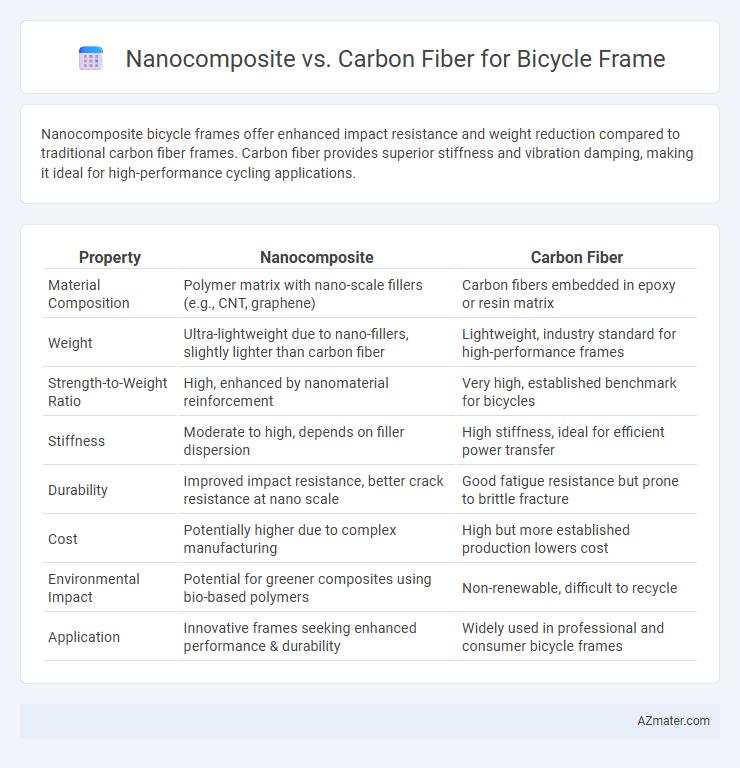Nanocomposite bicycle frames offer enhanced impact resistance and weight reduction compared to traditional carbon fiber frames. Carbon fiber provides superior stiffness and vibration damping, making it ideal for high-performance cycling applications.
Table of Comparison
| Property | Nanocomposite | Carbon Fiber |
|---|---|---|
| Material Composition | Polymer matrix with nano-scale fillers (e.g., CNT, graphene) | Carbon fibers embedded in epoxy or resin matrix |
| Weight | Ultra-lightweight due to nano-fillers, slightly lighter than carbon fiber | Lightweight, industry standard for high-performance frames |
| Strength-to-Weight Ratio | High, enhanced by nanomaterial reinforcement | Very high, established benchmark for bicycles |
| Stiffness | Moderate to high, depends on filler dispersion | High stiffness, ideal for efficient power transfer |
| Durability | Improved impact resistance, better crack resistance at nano scale | Good fatigue resistance but prone to brittle fracture |
| Cost | Potentially higher due to complex manufacturing | High but more established production lowers cost |
| Environmental Impact | Potential for greener composites using bio-based polymers | Non-renewable, difficult to recycle |
| Application | Innovative frames seeking enhanced performance & durability | Widely used in professional and consumer bicycle frames |
Introduction to Advanced Bicycle Frame Materials
Nanocomposite materials combine nanoparticles with polymers, enhancing stiffness and impact resistance while remaining lightweight for bicycle frames. Carbon fiber offers exceptional strength-to-weight ratios and excellent fatigue resistance, making it a preferred choice for high-performance bikes. Comparing nanocomposites and carbon fiber involves evaluating factors like durability, weight, cost, and manufacturing processes for advanced frame development.
What Are Nanocomposites?
Nanocomposites are advanced materials composed of a matrix embedded with nanoscale fillers such as nanoparticles, nanotubes, or nanofibers, enhancing mechanical properties like strength, stiffness, and durability. Compared to traditional carbon fiber composites used in bicycle frames, nanocomposites offer superior impact resistance and fatigue performance due to the improved interfacial bonding and higher surface area of nanofillers. These attributes make nanocomposites a promising alternative for lightweight, high-performance bicycle frames with enhanced structural integrity.
Understanding Carbon Fiber in Cycling
Carbon fiber, renowned for its exceptional strength-to-weight ratio and stiffness, revolutionizes bicycle frame design by providing lightweight yet durable structures ideal for performance cycling. Nanocomposites, which integrate nanoparticles into a polymer matrix, enhance mechanical properties and impact resistance but typically do not match carbon fiber's rigidity and weight benefits in high-stress applications like racing bikes. Understanding carbon fiber's molecular structure and fiber alignment explains its superior load distribution and vibration damping, making it the preferred choice for competitive cycling frames seeking maximum efficiency and responsiveness.
Comparative Strength and Stiffness
Nanocomposite bicycle frames exhibit enhanced strength and stiffness due to the synergistic combination of matrix materials and nanoscale reinforcements, resulting in improved impact resistance and durability compared to traditional composites. Carbon fiber frames offer exceptional stiffness-to-weight ratios and high tensile strength, making them ideal for performance-focused cycling applications that demand lightweight and rigidity. While carbon fiber excels in stiffness, nanocomposites provide superior toughness, reducing the risk of fracture under dynamic loads.
Weight Considerations: Nanocomposite vs Carbon Fiber
Nanocomposite bicycle frames often offer a lighter alternative to traditional carbon fiber models due to their enhanced material composition and optimized fiber distribution. Carbon fiber frames, while lightweight, usually have higher density and may incorporate additional layers for strength, increasing overall weight. Advances in nanocomposite technology enable reduced material usage without compromising durability, resulting in lighter and more efficient bicycle frames.
Ride Quality and Vibration Damping
Nanocomposite bicycle frames offer superior vibration damping due to their enhanced matrix properties and nanoscale filler dispersion, resulting in a smoother ride compared to traditional carbon fiber frames. Carbon fiber frames excel in stiffness-to-weight ratio, providing responsive handling but transmitting more road vibrations to the rider. The integration of nanomaterials in composite matrices systematically reduces micro-vibrations, improving overall ride comfort without compromising structural performance.
Durability and Resistance to Damage
Nanocomposite bicycle frames exhibit superior durability due to the integration of nanoscale fillers, which enhance resistance to fatigue, impact, and environmental degradation compared to traditional carbon fiber. Carbon fiber frames offer high strength-to-weight ratios but are more susceptible to micro-cracking and delamination under repeated stress or sharp impacts. The increased toughness and damage tolerance of nanocomposites result in longer service life and reduced maintenance, making them a preferable choice for cyclists prioritizing frame longevity.
Cost and Manufacturing Differences
Nanocomposite bicycle frames typically offer lower material costs compared to carbon fiber due to the use of nanoparticles enhancing resin properties without expensive carbon fiber sheets. Manufacturing nanocomposites often involves more scalable processes like injection molding or compression molding, reducing labor intensity and production time. Carbon fiber frames require precise layup of carbon sheets and curing in autoclaves, which increases manufacturing complexity and overall cost.
Environmental Impact of Each Material
Nanocomposite bicycle frames exhibit lower environmental impact due to their potential for enhanced recyclability and lesser energy-intensive production processes compared to carbon fiber. Carbon fiber manufacturing involves high energy consumption and produces significant waste, resulting in a larger carbon footprint and challenges in end-of-life disposal. Nanocomposites, incorporating nanoscale fillers, offer improved durability and weight reduction, which can extend bike lifespan and reduce overall environmental costs.
Future Trends in Bicycle Frame Innovation
Nanocomposite materials offer enhanced strength-to-weight ratios and improved impact resistance compared to traditional carbon fiber, driving innovation in bicycle frame design. The integration of nanomaterials like graphene and carbon nanotubes promises greater durability and stiffness while reducing frame weight significantly. Future trends indicate a shift toward hybrid frames combining nanocomposites with carbon fiber to optimize performance, sustainability, and manufacturing efficiency in high-end bicycles.

Infographic: Nanocomposite vs Carbon fiber for Bicycle frame
 azmater.com
azmater.com